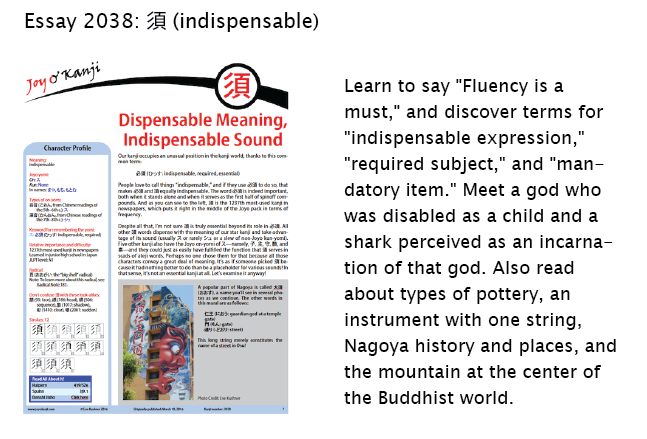Taking on Time
On the surface, time seems inalterable. After all it's the fourth dimension, and we can't exactly take that on! However, we do manipulate time in all sorts of ways. Last weekend most of the United States set clocks ahead an hour, and nearly a week later this still doesn't feel natural. I can't seem to wake up before 8:00!
Lately, several other things have made me consider time from a different angle. For instance, essay 1251 on 恒 (constant, established), which I posted last week, contains the following passage: "Did you know that there’s more than one kind of time? There’s solar time, measured with the sun as a reference point. However, you can also keep track of time using stars other than the sun. And if you use 'sidereal time' (where 'sidereal' means 'determined by or from the stars'), you will come up with slightly shorter days, months, and years."
Here, by the way, is the term for "sidereal time":
恒星時 (こうせいじ: sidereal time) star (1st 2 kanji) + time
Just as we usually assume that the sun needs to be at the center of any star-based timekeeping system, we also take it for granted that time must be carved up into twelves. But is that necessarily so? In the new essay 2038 on 須 (indispensable), I touch on the following word:
しゅゆ or すゆ (須臾: (1) one-thirtieth of one day, 48 minutes; (2) little while; (3) moment) very short time + very short time
This idea came from a Sanskrit concept:
muhūrta (one-thirtieth of a day, which corresponds to 48 minutes in today’s time units)
Imagine having 48 minutes as a unit. I know 48 is divisible in all sorts of wonderful ways, but the number still seems unwieldy if you picture a clock.
Speaking of clocks, I started working with a dog trainer on Tuesday. She specializes in TTouch (Tellington Touch), a wonderful way of resetting the nervous system and thereby calming agitated dogs (or elephants, horses, or many other creatures, including humans!). The trainer has me trace mini circles on Masala's and Chai's torsos, imagining that I'm starting at 6:00, going around to 6:00 again and then proceeding past that to 9:00. The idea behind a circle and a quarter is if you do just a full circle, you're reinforcing habitual thinking and behavior. With an extra quarter turn, you're going beyond the old habits. I'm also supposed to clasp each tail and move it around a circle and a quarter in either direction. I keep picturing Masala and Chai as clocks that I'm winding or resetting!
Here's another concept of time that I encountered this week:
初葉 (しょよう: start of a certain era) start + era
中葉 (ちゅうよう: middle of a certain era) middle + era
末葉 (まつよう: end of a certain era) end + era
You can use the second term this way:
18世紀中葉、英国に産業革命が起こった。
In the middle of the 18th century, the Industrial Revolution occurred in Britain.
世紀 (せいき: century); 英国 (えいこく: Great Britain); 産業革命 (さんぎょうかくめい: Industrial Revolution); 起こる (おこる: to occur)
As 葉 usually means "leaf," it's unexpected to find it as "era" here. Kanjigen says that this usage likens an era to piled-up leaves! I'm not sure why, and Kanjigen doesn't say. It's fodder for the imagination, then. Perhaps the passing years seem as worthless as dead leaves, the "pile" growing unthinkably large as we age. I hope these three -葉 terms don't reflect that depressing a take on time!
This week I also examined surprising aspects of 八 (eight) and came upon this word:
八千代 (やちよ: eternity; thousands of years) 8,000 (1st 2 kanji) + generation
The etymological explanation is simply that 8,000 years is a very long time, akin to forever. Indeed, that's true. But 9,000 years is even longer, and while we're at it, why not round up to an even 10,000 years?
Ah, there I go again, feeling more comfortable with standard ways of dividing things into units. I suppose if I relaxed enough, I could feel that "eight is enough." After all, it works for an octopus! But it's hard to shift such thinking, isn't it?
Here's one more conceptual scheme that truly made my head spin. I found out that in the Edo era (1603–1867), 八 represented the window from 2:00 to 4:00, both a.m. and p.m. We still find traces of this notion in the following term:
おやつ (お八つ: midafternoon snack, usually eaten around three o'clock)
To understand where 八 fit into the larger system, check out an image showing how people told time back then. The Japanese used two systems concurrently, both incorporating two-hour chunks of time.
One system (the outer circle in the image) used the Chinese zodiac. Each two-hour unit was named for one of the 12 zodiacal symbols.
The other system (the inner circle) divided the day into 12 units of roughly two hours each (though the actual amount of time in those windows varied with the sunrise and sunset). The units were numbered, and the series of numbers repeated once. But instead of having units 1 through 6, the system used numbers 4 through 9! Actually, it went backward, from 9 to 4! So the window from midnight to 2:00 a.m. is marked 九 (9). Then 2:00 a.m. to 4:00 a.m. is labeled 八. We again see 八 denoting the span from 14:00 (2:00 p.m.) to 16:00 (4:00 p.m.).
I can't imagine why the system didn't last! Maybe some things do improve over time!
Have a great weekend. But before you go, check out this preview of the new essay 2038 on 須:


Comments